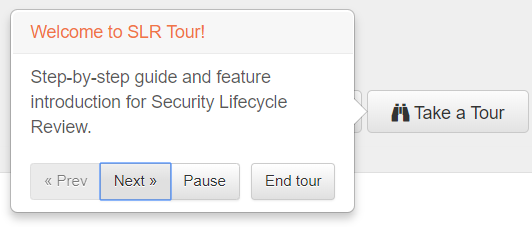Security Lifecycle Review (SLR)—What’s in the Report?
Table of Contents
Expand all | Collapse all
-
- About Security Lifecycle Review (SLR)
- Security Lifecycle Review (SLR)—What’s in the Report?
- Activate the Security Lifecycle Review (SLR) App
- Create a New Security Lifecycle Review (SLR) Report
- Customize Security Lifecycle Review (SLR) Reports
- Security Lifecycle Review (SLR) Support Requirements
- Security Lifecycle Review (SLR) Updates
Security Lifecycle Review (SLR)—What’s in the Report?
Provides information about what information is contained in an SLR.
Security Lifecycle Review (SLR) reports
summarize the security and operational risks your organization faces,
and breaks this data down so that you can quickly and easily identify
how to reduce your attack surface. Each section of the SLR report
focuses on different types network activity—application usage, web-browsing,
data transfer, and threat prevalence—and surfaces the greatest risks
in each area. SLR reports display your organization’s statistics
alongside the averages for your industry peers, so you can best
understand your results in context.
After you generate an SLR report, or open an existing
SLR report, there is an option to Take a Tour of
the report. Select this option to walk through and learn about each
section of an SLR report.

Executive Summary | Provides a bird’s-eye view of the state
of your network. Statements on the total number threats detected
on your network and the number of applications in use (including
high-risk and SaaS applications) allow you to quickly assess how
exposed you are to risk and focus areas for more strict or granular
security policy control. 
|
Applications | Gives you a view into the applications traversing
your network, especially highlighting applications that are commonly
non-compliant and/or can introduce operational or security risks.
Application findings also include total and application-level bandwidth
consumption and the applications in use according to type (like
media or collaboration). This application visibility allows you
to weigh the business value of applications in use on your network,
against the risk applications can introduce (such as malware delivery,
data exfiltration, or excessive bandwidth consumption). 
|
SaaS Applications | Highlights the SaaS applications in use
on your network, including the SaaS apps that are transferring the
most data and those that have risky hosting characteristics (frequent
data breaches, poor terms of service, etc.). Understanding the presence
of SaaS apps on your network can help you work towards safely enabling
the apps that are critical to your business, while providing threat
protection and preventing data leaks. 
|
Advanced URL Filtering Activity | Summarizes the web browsing activity on
your network. Uncontrolled web access can result in exposure to
malware, phishing attacks, and data loss. The advanced URL filtering
activity report is broken down into several sections: If
you are operating PAN-DB, but do not have an advanced URL filtering
subscription, only the relevant network activity metrics are displayed.

|
File Transfer | Gives you insight into the most commonly-used
file types on your network, and what applications are being used
to transfer these files. You can use the analysis provided here
to consider more strict controls that prevent sensitive or proprietary
data from leaving your network, and the delivery of malicious content
into your network. 
|
Threats | Summarizes your organization’s risk exposure
by breaking down the attacks detected in your network:
Your
Threat summary also breaks down the high risk file types detected
on your network, and the file types found to have delivered malware
that was unknown until WildFire detection. Examine this data to best
assess where you can immediately start to reduce your attack surface. New threat data is
now included in your report:

|
DNS Security Analysis |
Summarizes your exposure to threats hidden within DNS traffic. DNS is
an often overlooked attack vector. Advanced attackers in particular
use DNS-based techniques like DNS tunneling and DGAs (domain generation
algorithms) to exfiltrate data and to set up command-and-control
(C2) channels, respectively. To give you a view into malicious DNS
activity on your network, the DNS Security Analysis section also
reveals:
The Advanced DNS Security and Advanced DNS Security Resolver
subscriptions offer additional detection and/or deployment
possibilities. To reflect those enhancements, you also get access to
additional widgets that provide insight into specific detections and
performance metrics relevant to those subscriptions.
The following sections are available in each report:
DNS Security Analysis (Summary): Provides an overview report
about the DNS activity in your network. This includes how much of
your DNS traffic is malicious (including the associated malware
families), the host country of the malicious threats, and the total
number of DNS requests analyzed.

Traffic Distribution: Provides a breakdown of the DNS requests
and responses from your network, based on the DNS categories as
defined by DNS Security.

DNS Traffic Insights: Provides domains that are most requested
from within your network, organized by DNS traffic type.

Malicious Traffic Insights: Provides a list of the top
malicious domains accessed from your network, and the countries
hosting most of these malicious domains.

Known Malware and Families: Provides a list of malicious
domains and any malware families that are associated with the top
domains in your network.

Advanced DNS Security Resolver: Provides a list of
Malicious,
High-Risk, and
Benign traffic entering your network
using the Palo Alto Networks Advanced DNS Security Resolver. If you
are using third-party resolvers in your network, the same breakdown
is listed based on each resolver.


DNS Zone Misconfiguration: Provides a listing of public-facing
misconfigured domains that are inadvertently created by domain
owners who point alias records to third party domains using CNAME,
MX, NS record types, using entries that are no longer valid. This
can allow an attacker to take over the domain by registering the
expired or unused domains.

|
Summary | The final summary provides recommendations
that you can consider to safely enable the applications you need
to do business, while reducing the organization’s overall threat
exposure. |
